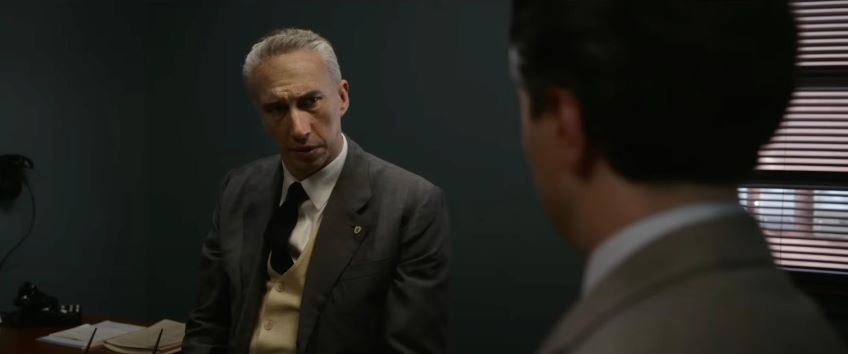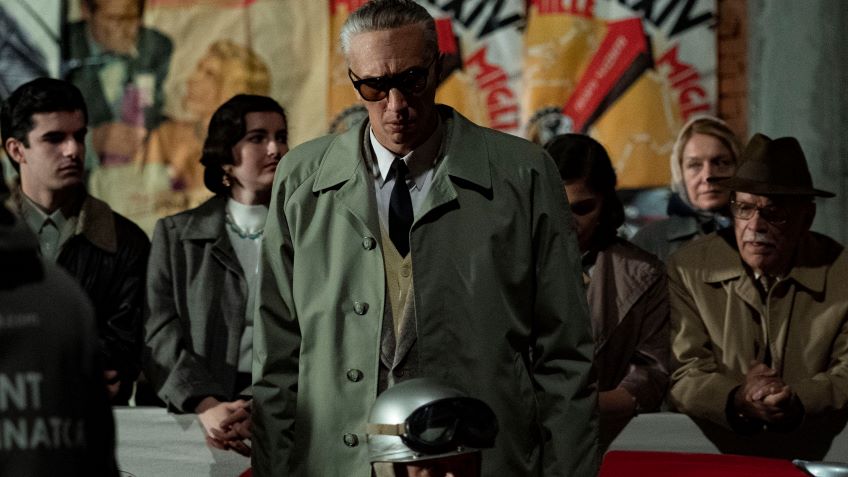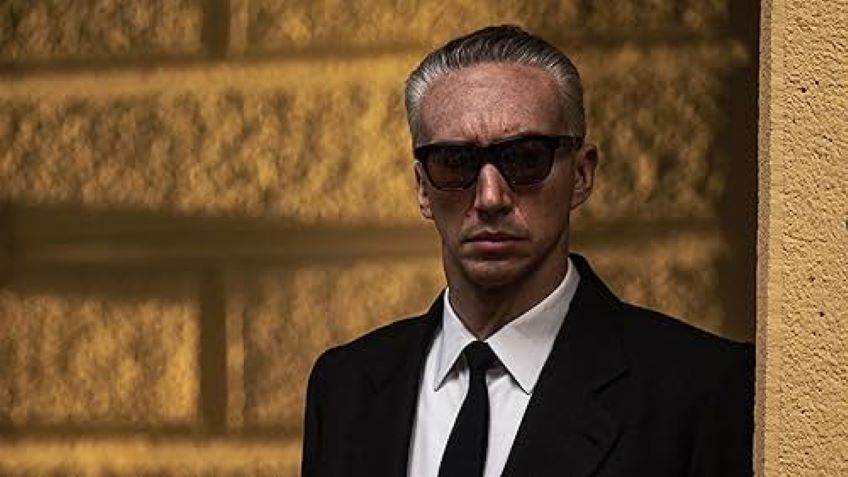Joyce Glasser reviews Ferrari (December 26, 2024) Cert 15, 130 mins. In cinemas & on SKY TV in 2024
Two years ago eighty-four year old Ridley Scott’s biopic House of Gucci was released, staring Adam Driver as Maurizio Gucci in a film combining the messy family disputes, Gucci’s explosive marital life with the business of the famous brand. The film was in English with a variety of distracting attempts at accents. There are similarities between House of Gucci and eighty-year-old Michael Mann’s new film, Ferrari the biopic of another iconic Italian businessman, Enzo Ferrari, also starring Adam Driver, aged with makeup and a head of white hair, dark glasses, black and white Italian suits, and a dodgy accent.
With the exception perhaps of Driver, the resemblances are coincidental. Ferrari was conceived just over twenty years ago. Troy Kennedy Martin – the creator of Z-Cars and writer of The Italian Job – the film’s credited scriptwriter, died in 2009. The film is also dedicated to Sydney Pollock who died in 2008.
If the self-destruction in House of Gucci was dissipated with humour, Mann and Martin infuse every scene with the spectre of death and reserve colour for the red cars that dominate the Mille Miglia. Even the beautiful Italian countryside and authentic houses and their 1950’s interiors are muted.

Enzo Ferrari is in the business of making and selling racing cars, hiring and managing drivers, and managing death. This is made clear early on in scene of foreshadowing. Enzo is at a practice race track with his rival, Maserati, timing a driver. Ferrari built his business in the ruins of post-war Italy from 1947, and in 1957 there were no health and safety regulations, no protection built into the tracks or cars or racing gear. We expect to see horses on the isolated dirt track rather than cars.
An attractive, poised looking young woman has accompanied the driver who is clearly aiming to impress her and Enzo. As he reaches a curve, the car jams and spins in the air, crashing nearby. After closing his stop watch Enzo matter-of-factly blames the death on class. The driver, he claims, was distracted and confused by his pushy mother who encouraged him to pursue a girl above his station. Driver has the difficult challenge of holding back every emotion in order to stay in character, but this almost unbroken self-control risks distancing him from viewers.
Enzo thrives on speed. After giving up racing to build faster and faster cars, he learns to identify in other drivers what motivates them and what is holding them back or what is nagging at them – such as a pushy mother. More like a coach than the owner of a car manufacturing plant, we hear his strikingly specific comments to each driver before the big Mille Miglia race that is the spectacular climax of the film.
Another unusual decision for a biopic, Mann and Martin focus the action extremely tightly, on a three month period in 1957, although it is certainly the most fraught and game-changing in Enzo’s life. It is moreover a period where death hovers over every aspect of Enzo’s life, even the prospect of bankruptcy, or the death of his dream.

Enzo is only interested in the business of racing, and selling to wealthy amateur sports enthusiasts or movie stars is a by-product. His business manager Cuoghi (Giuseppe Bonifati) is blunt about this business model. They are only manufacturing 100 cars a year, and to turn a profit, they need to make 400, but to reach this number they require outside investment. Henry Ford II might be interested, but Enzo is a control freak and refuses any deal where he is not in total control.
Against this background he and his wife Laura (Penelope Cruz) are still grieving the death the previous year of their only child, Alfredo. He died from muscular dystrophy at the age of 24. Laura, distraught at her husband’s infidelities is trying to blame him, while perhaps she and her mother-in-law think it was something wrong with Laura’s body. The boy’s death has ended the marriage although there is still a sign of tenderness, the vestiges of years together and their hope that Alfredo would be Enzo’s heir.
Cruz plays Laura as a passionate, fiery, intelligent (a surprise decision she makes might have tipped the company over the edge, but her ideas to reinvest the cash bear fruit) woman, still beautiful but prone to outbursts of rage, revenge and frustration at Enzo’s infidelities. His partner in the business, Laura is willing to sign over her half of the company to him so he can negotiate with an investor in exchange for the lump sum in cash. Enzo agrees on condition that she not cash the cheque until the deal is completed because otherwise, the bank will foreclose on the business.
While visiting the bank, Laura discovers some company payments she is unaware of and one is to buy a property. When she investigates, she discovers that Enzo has been living a double life with a mistress Lina Lardi, (Shailene Woodley) and their son Piero (Giuseppe Festinese). Laura can put up with casual infidelities, but not a long term homelife with a mistress and a son who is going to replace her Alfredo.
With the tension cranked up to breaking point, everything depends on the high profile Mille Miglia race, in which Ferrari, which won the previous year, is well placed to win again. In a chilling scene the night before the race, Ferrari’s top drivers, Alfonso de Portago (Gabriel Leone), Peter Collins (Jack O’Connell) and Piero Taruffi (Patrick Dempsey) write “last words” messages to loved ones, leaving the envelopes in their hotel rooms only half hoping to tear them up in two days.
Enzo remembers to get, for Piero, the autograph of the handsome Spanish playboy, extreme sport, aristocratic driver de Portago who is driving with a navigator. He is kissed good luck by his beautiful girlfriend Linda Christian (Sarah Gadon), the Mexican film star and arguably the first Bond girl.
The 992 mile (1,597 kilometre) round trip road race from Brescia and Rome and back is watched by millions because of the risk and accessibility. As the drivers try to keep maximum speeds through the crowded streets of Rome and, along country roads lined with families cheering on the drivers, the tension mounts to almost unbearable levels. Don’t look up the race – 1957 was the last time it took place. Let the haunting climactic scenes engulf you. You wish Mann gave us more time to get to know the drivers, so we could be invested in their individual stories, but the incident outside of Guidizzolo, forty miles from Brescia, will stay with you forever.




